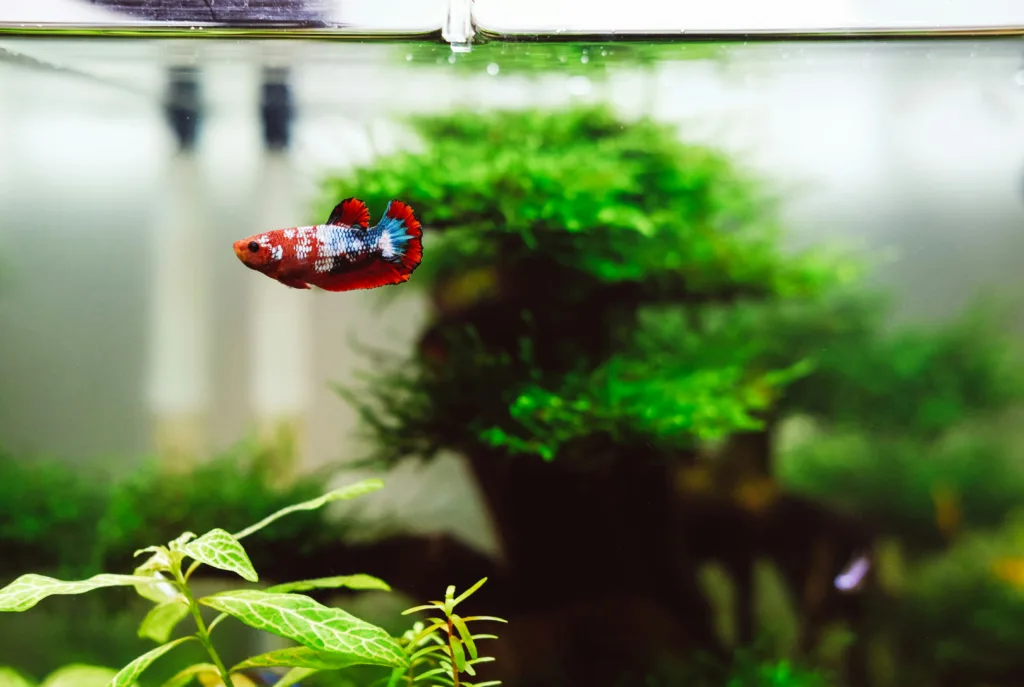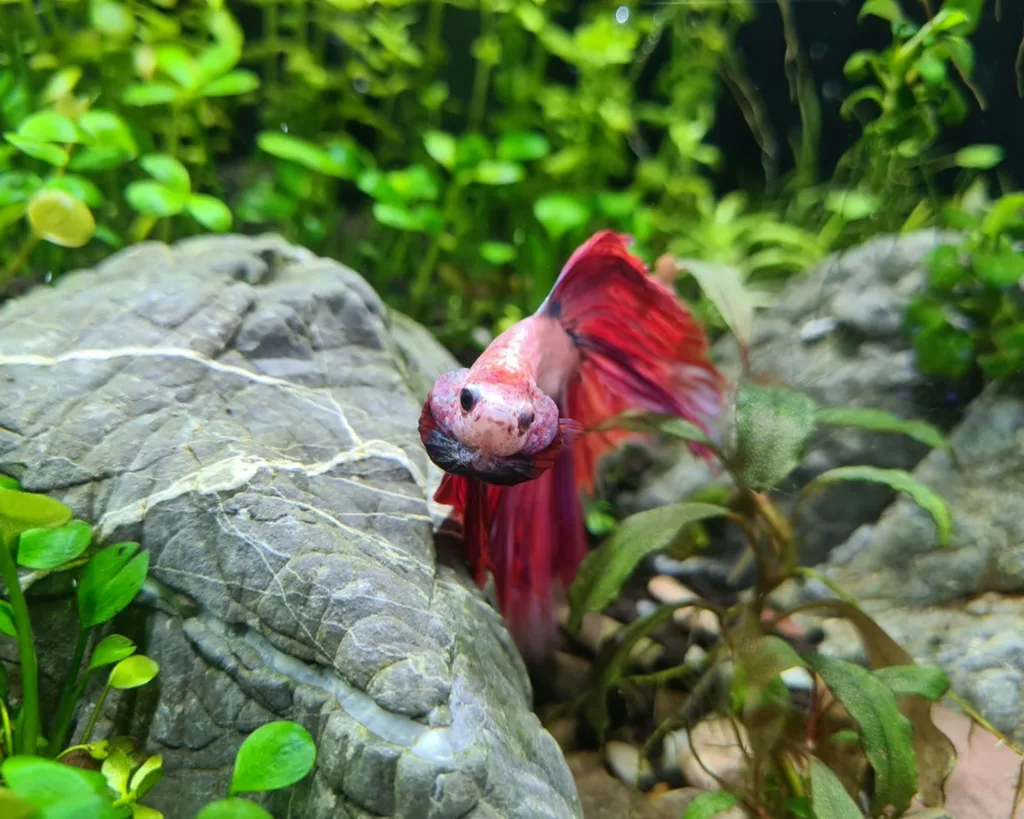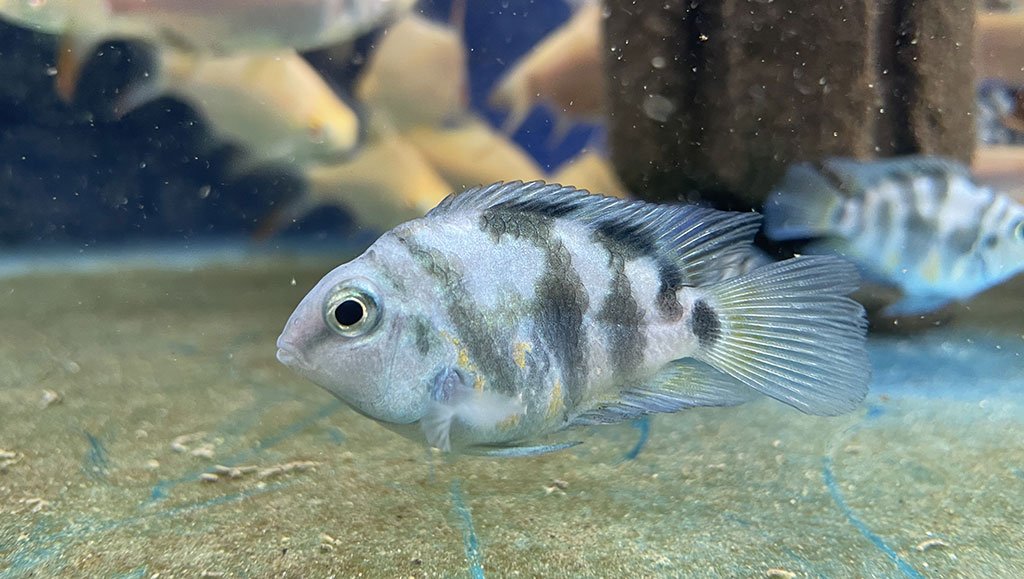Welcome, fellow fish enthusiasts! If you’re like me, you understand that creating the perfect home for your betta fish isn’t just about adding water to a tank; it’s about creating a thriving ecosystem that mirrors their natural habitat. That’s why I’m super excited to share with you my discoveries on the best plants to introduce into your betta’s world.
After countless hours of research and experimenting in my own tanks, I’ve found that the right aquatic plants can make all the difference. They not only make your aquarium look more vibrant and natural but also provide crucial hiding spots for your betta, helping reduce stress and improve their overall health. From my adventures, I’ve learned which plants are betta-friendly and which ones to avoid.
By the end of this article, you’ll have a better understanding of how to choose plants that are not only safe but beneficial for your betta fish, adding beauty and balance to their environment. Whether you’re a seasoned aquarist or just starting out, I’m here to guide you through selecting the perfect greenery for your vibrant aquatic companion. Trust me, your betta will thank you!
Key Takeaways
From my personal journey through the world of aquascaping, especially when it comes to nurturing a thriving environment for betta fish, I’ve learned quite a bit about which plants really make a difference. Here are the key takeaways from my experience:
- Anubias: These plants are practically a miracle for any betta tank. Their hardy nature and low light requirement make them easy to care for, which was a huge plus for me. Anubias has been a constant in my tank setups, contributing to the aesthetic appeal and the overall health of the ecosystem.
- Java Ferns: Similar to anubias, java ferns are another variety that has done exceptionally well in my betta tanks. They don’t need much light and their robustness means they can thrive even if you’re a beginner. My bettas seem to love the cover and the ambiance these ferns provide.
- Mosses, particularly Java Moss: If you’re looking to create a sanctuary that your bettas will adore, then moss, especially java moss, is the way to go. It offers a soft, comforting bed for your bettas and adds a beautiful touch of green to the tank. Seeing my bettas swim through the moss, exploring and relaxing, has been a highlight for me.
Benefits of Live Plants for Betta Fish Tanks
Before we jump into the magical world of aquatic plants, let’s take a moment to appreciate how these green wonders can transform your betta’s home. Having experimented with a variety of setups, I can confidently say that integrating live plants into your betta tank is a game-changer. Here’s why:
Natural Filtration and Oxygenation
First off, live plants are like Mother Nature’s own filtration system. They help break down waste products, reducing the buildup of harmful toxins. In my tanks, I’ve noticed a significant improvement in water quality since introducing plants. Plus, they release oxygen during photosynthesis, providing your betta with a fresher, more oxygen-rich environment. It’s amazing to see the difference in my betta’s vitality and energy levels with this natural boost!
Environmental Enrichment and Behavioral Benefits
Another aspect I’ve thoroughly enjoyed observing is how live plants affect my betta’s behavior. These plants offer a more engaging and complex environment, closely mimicking their natural habitats. I’ve seen my bettas indulge in exploring, playing, and even resting among the leaves. It’s heartwarming to see them so content and stress-free, knowing that this enrichment plays a crucial role in their well-being.
Aesthetic Enhancement and Aquascaping Opportunities
There’s no denying the visual appeal of a well-planted betta tank. The vibrant colors and varied textures of aquatic plants can turn an ordinary aquarium into a stunning piece of living art. For me, aquascaping has become a fulfilling hobby. It’s not just about beautifying the tank; it’s about creating a harmonious environment that reflects the natural beauty of our planet. Each tank is a canvas, and the plants are my palette.
Improved Tank Stability and Balance
From my experience, adding live plants stabilizes the tank environment. Plants play a crucial role in cycling nutrients and maintaining balanced water parameters. This stability is beneficial for both the fish and the microscopic world of beneficial bacteria that support a healthy aquarium system. A stable tank means happier, healthier fish, and fewer headaches for us caretakers.
Algae Reduction
Last, but definitely not least, live plants compete with algae for nutrients, light, and space. I’ve noticed a striking decline in unwanted algae growth since the introduction of live plants. By maintaining a balanced plant life, you’re essentially keeping algae in check naturally. Nobody likes scrubbing algae, so this has been a huge plus in my book.
Factors to Consider When Choosing Plants for Betta Fish Tanks

Selecting the right plants for your betta fish tank can be quite the adventure, and it’s one I’ve embarked on more times than I can count. Through trial and error, I’ve learned there are several key factors to consider to ensure your aquatic plants and betta fish live in harmony. Here’s a rundown based on my own experiences:
Compatibility with Betta Fish: Soft Leaves, No Sharp Edges
First and foremost, it’s crucial to choose plants that are safe for your betta. In my tanks, I always go for plants with soft leaves and avoid those with sharp edges or points. Betta fish have delicate fins that can easily tear on rough surfaces, and I learned this the hard way. Opting for plants like Anubias or Java Fern, which have soft, smooth leaves, can prevent injuries and keep your betta happy and healthy.
Growth Rate and Maintenance Requirements
Another aspect to consider is the plant’s growth rate and how much maintenance it requires. Some plants grow rapidly and can take over your tank if not trimmed regularly, while others grow slowly and need less attention. Based on my experience, starting with low-maintenance plants like Java Moss or Anacharis can make your life easier, especially if you’re a beginner.
Light and Temperature Requirements
Plants, just like fish, have specific light and temperature needs. Ensuring your tank’s conditions match those requirements is key for plant health and growth. For instance, I’ve found that while some plants thrive in high light conditions, others do just fine in low-light setups. Matching these needs with your tank’s conditions ensures your plants flourish, positively impacting your betta’s environment.
Rooted vs. Floating Plants
Deciding between rooted and floating plants can significantly affect your tank’s dynamics. Rooted plants offer a more structured look and can provide hiding spots and territories for your betta. On the flip side, floating plants, such as Duckweed or Water Sprite, can offer shade and additional hiding spots at the surface. Personally, I love mixing both to give my betta fish the best of both worlds.
Space and Tank Size
It’s easy to get carried away with adding plants, but considering the size of your tank and the space plants will occupy is vital. Overcrowding can stress your betta and affect water quality. From my experience, planning your layout and choosing plants that fit the scale of your tank will create a more harmonious and aesthetically pleasing environment.
Plant Benefits and Contribution to the Ecosystem
Finally, consider what each plant brings to the table—or in this case, to the tank. Some plants are excellent at oxygenating the water, while others are great at absorbing nitrates. For instance, I’ve included Hornwort in my setups for its unparalleled nitrate absorption capabilities, contributing to a healthier tank ecosystem.
Top Live Plants Recommended for Betta Fish Tanks
Navigating through my own aquatic gardening adventures has taught me so much about which plants truly make a betta fish’s world vibrant, healthy, and stimulating. Based on my experiences, here are my top picks for live plants that will make your betta tank a thriving, underwater oasis.
Anubias spp.
Anubias plants have been a steadfast choice in my betta tanks. What draws me to Anubias is their hardiness and the fact that they can thrive under low light conditions. Their broad, soft leaves provide perfect lounging spots for bettas, and they’re practically invincible, making them ideal for beginners like I once was.
Java Fern (Microsorum pteropus)
Java Fern, with its rugged look and minimal care requirements, has been another favorite. To me, its greatest asset is how easily it attaches to rocks and driftwood, transforming tank décor into natural, lush landscapes. Its slow growing nature means less maintenance work on your part—an absolute win in my book.
Java Moss (Taxiphyllum barbieri)
Java Moss is like the cozy carpet of the aquatic world for bettas, offering them endless entertainment and hiding spots. Its tolerance for a range of conditions and easy propagation makes it a top choice for anyone looking to add a verdant touch without much fuss.
Amazon Sword (Echinodorus spp.)
The Amazon Sword is my go-to for creating a dramatic backdrop in my tanks. Their large leaves not only add to the aesthetic appeal but also serve as excellent hiding and resting places for bettas. They can grow quite large, so I recommend them for bigger tanks where they can truly flourish.
Marimo Moss Balls (Aegagropila linnaei)
These aren’t just plants; they’re almost like pets themselves. Marimo Moss Balls, with their quirky, spherical shape and ease of care, can add character to any betta tank. They’re fascinating to bettas and to me, offering something a little different from the usual fronds and leaves.
Water Wisteria (Hygrophila difformis)
The lacy leaves of Water Wisteria create a beautiful, delicate ambience that I’ve found bettas love to weave through. It’s a fast grower, great for filling up spaces quickly, and you can plant it or leave it floating, giving you flexible aquascaping options.
Hornwort (Ceratophyllum demersum)
Hornwort is my secret weapon for nutrient control. It absorbs nitrates like no other, aiding in keeping the water quality high for my bettas. Its feathery fronds can float or be anchored, though I prefer letting it float to provide some cover at the top of the tank.
Cryptocoryne spp.
Cryptocoryne varieties are intriguing due to their varied colors and leaf shapes, offering a tapestry of textures for any tank. Slow growth and low light requirements make them a fuss-free addition, though they can be a bit sensitive to changes in water conditions.
Duckweed (Lemna minor)
While some aquarists consider Duckweed a nuisance due to its rapid growth, I see it as a lovely light filter that offers a natural, river-like canopy for my bettas. It helps reduce algae and keeps water parameters stable. Just be ready to thin it out regularly to prevent total surface coverage.
Water Sprite (Ceratopteris thalictroides)
Lastly, Water Sprite has a special place in my heart and tanks. This plant can be used as a floating plant or rooted down. Its fine leaves create a soft, dense area for bettas to hide and play in. It’s also incredibly resilient, making it fantastic for both seasoned and newbie aquarists.
Planting and Maintenance Tips for Betta Fish Tanks

Creating a verdant paradise for your betta isn’t just about choosing the right plants—it’s also about how you plant and take care of them. I’ve learned a few tricks along the way that I’m excited to share with you. Remember, whether you’re a seasoned aquarist or just starting, these tips can help ensure your aquatic garden thrives.
Proper Planting Techniques: Anchoring, Drifting, or Floating
When I first started, I quickly realized not all plants like to be planted the same way. Anchoring plants with robust root systems into the substrate gives them stability and access to nutrients. For plants that prefer to roam free, drifting or floating can create a dynamic look in your tank and provide your betta with interesting areas to explore. Remember, some floating plants can block out light, so balance is key.
Providing Adequate Lighting and Fertilization
Light is life for aquatic plants. I’ve found that LED aquarium lights with adjustable brightness are fantastic for simulating natural daylight cycles. Keep in mind the lighting needs of your specific plants—too little and they’ll struggle; too much and you might invite algae. Fertilization is just as crucial. A balanced liquid fertilizer can work wonders, especially for water column feeders. Just follow the recommended dosages to avoid nutrient overload.
Trimming and Pruning to Prevent Overgrowth
Overgrowth was a challenge I faced early on. It can overshadow other plants and change water parameters. Regular trimming and pruning not only keep your tank neat but also encourage healthy growth. Don’t be afraid to cut back those fast-growers. Your tank (and your betta) will thank you for it.
Monitoring for Signs of Disease or Pests
Every now and then, I inspect my plants for signs of disease or pests. Early detection is key to preventing an outbreak. Watch out for discolored leaves or signs of snail infestations. If you spot trouble, quarantining the affected plant can save the rest of your aquatic garden.
Water Quality Management
Maintaining excellent water quality has been paramount. Regular water tests and changes are crucial, especially when adding new plants. These practices help prevent the build-up of harmful substances and ensure a healthy environment for both your betta and plant friends.
Experimentation and Adaptation
Lastly, don’t be afraid to experiment and adapt. What works for one aquarium enthusiast might not work for another due to differences in water chemistry, lighting, or even regional climate. Don’t get discouraged by setbacks; consider them learning opportunities.
Aquascaping Ideas for Betta Fish Tanks
Creating a visually stunning and biologically nurturing environment for bettas through aquascaping is a joyful process that combines creativity with an understanding of your aquatic pets’ needs. Here, I’ll share some of my favorite ideas and techniques from personal experience for beautifying your betta fish tank while ensuring it remains a healthy habitat.
Creating Naturalistic Environments with Live Plants
One of my favorite approaches is to simulate a betta’s natural habitat using live plants. Using species like Java Fern, Anubias, and the previously mentioned Water Sprite, you can create lush landscapes that not only look gorgeous but also enhance the tank’s ecosystem. Planting densely in some areas while leaving open swimming spaces mimics the betta’s natural Southeast Asian environments, providing them with both the cover and the territory they instinctively seek.
Incorporating Hardscape Elements: Driftwood, Rocks, and Caves
Hardscape materials like driftwood, rocks, and caves not only contribute to the aesthetic appeal of your tank but also have practical uses. For instance, driftwood can serve as a platform for attaching ferns and mosses, while rocks and caves offer hiding spots that provide bettas with a sense of security. I’ve found that arranging these elements in a way that creates natural barriers and territories encourages interesting behaviors and reduces stress in bettas.
Balancing Aesthetics with Functionality: Creating Swimming Spaces and Hiding Places
It’s crucial to strike a balance between making your tank look beautiful and keeping it functional for its inhabitants. I ensure there are ample open spaces for swimming and sufficient hiding spots crafted from plants and hardscape. This setup mimics the open waters and dense vegetation of their natural habitats, promoting physical activity and reducing stress.
Utilizing Color and Texture Contrasts
Experimenting with different plant species and decor can add depth and excitement to your aquascape. I love pairing the bright greens of aquatic plants against darker substrates or rocks. Similarly, the delicate textures of fern leaves against the rugged surfaces of driftwood can create a striking visual impact. These contrasts not only please the human eye but also create a more engaging environment for your betta.
Creating Vertical Interest
Bettas are known to utilize every part of their environment, so I always think vertically as well as horizontally. Tall plants like Amazon Swords, or vertical features like stacked rocks, can coax your betta to explore these higher regions. Floating plants also add to this dimensional play, offering surface cover and feeding opportunities similar to what bettas would encounter in the wild.
Seasonal Changes and Festive Themes
Lastly, I sometimes introduce temporary changes to reflect seasons or festive themes. Adding specific plants or changing the color scheme with safe, non-toxic tank decorations can keep the aquascape fresh and engaging for both you and your betta. Remember, any new additions should be introduced gradually and monitored for their impact on tank health and betta behavior.
Addressing Common Concerns and FAQs About Plants in Betta Fish Tanks

Maintaining a planted betta tank is an incredibly rewarding experience, yet it comes with its share of challenges. I’ve encountered many of these head-on and would love to share my insights to help you deal with them more effectively.
Dealing with Algae Growth on Plants
Algae growth, while common, can be frustrating. From my experience, keeping algae at bay involves a balance of nutrients, lighting, and CO2 levels. If algae begin to appear on your plants, consider reducing the light your tank receives each day. Algae thrive on excess nutrients, so regular water changes and careful monitoring of fertilizer dosages can also make a big difference. In my tanks, introducing algae eaters, such as nerite snails or otocinclus catfish, has provided an added layer of defense against unwanted algae growth.
Compatibility of Live Plants with Tankmates
When introducing live plants, it’s crucial to ensure they are compatible with your betta and any other tankmates. Most bettas relish the complexity and shelter that plants provide, but some tankmates can be less plant-friendly. For instance, larger snails might accidentally uproot delicate plants, while some fish may nibble on your greenery. Selecting hardy plants like Java Ferns or Anubias, known for their resilience, can alleviate many compatibility concerns.
Preventing Plant-related Issues: Rotting, Melting, and Burying
Plant health can sometimes decline, leading to rotting, melting, or burying issues. Rotting usually signals poor water quality or a dead plant part, so prompt removal and water testing are key. Melting, especially common in newly introduced plants adapting to tank conditions, requires patience—healthy new growth typically follows. When burying plants, ensure their roots are properly anchored without burying the crown of root-based plants, which could cause rot.
Managing Light Intensity and Duration
Too much or too little light can pose problems for your aquatic plants. My plants have thrived under a consistent light schedule that mimics natural daylight, usually around 8 to 10 hours a day. Adjustable LED aquarium lights have been my go-to for precise control over intensity and duration, promoting healthy growth without provoking algae blooms.
Choosing Substrate for Plant Health
The right substrate plays a critical role in root development and nutrient uptake for aquatic plants. I’ve seen the best results with nutrient-rich substrates designed specifically for planted tanks. This type of substrate supports root growth and provides essential nutrients, leading to lush, vibrant plant life in your betta tank.
Consulting with Experts and Experienced Aquarists
Navigating the intricacies of maintaining a planted betta tank can sometimes feel overwhelming. However, one of the most enriching parts of this hobby has been connecting with aquascaping specialists, plant enthusiasts, and the broader community of betta fish keepers. Here’s how these connections can make a world of difference.
Seeking Advice from Aquascaping Specialists and Plant Enthusiasts
I’ve discovered that reaching out to aquascaping specialists and plant enthusiasts can incredibly elevate your aquascaping game. These individuals possess a wealth of knowledge about plant species that thrive in aquatic environments, innovative aquascaping techniques, and how to simulate natural habitats effectively. By attending workshops or visiting local aquarium clubs, I’ve gained invaluable advice tailored to my tank’s specific conditions and inhabitants.
Participating in Online Forums and Communities for Betta Fish Keepers
Online forums and social media communities dedicated to betta fish and aquascaping have been a treasure trove of inspiration and support. These platforms allow you to share experiences, successes, and challenges with fellow enthusiasts who are equally passionate about creating beautiful, healthy environments for their bettas. The camaraderie in these communities is palpable, and I’ve found answers to many of my questions through lively discussions and by browsing through past posts.
Consulting with Professional Aquarists and Hobbyists for Personalized Recommendations
Sometimes, a one-on-one consultation with a professional aquarist or an experienced hobbyist can provide personalized recommendations that are tailored specifically to your setup. I’ve taken the opportunity to have in-depth conversations during visits to local aquascaping stores and aquariums, discussing my tank’s dimensions, lighting conditions, and the peculiarities of my betta’s behavior. These personalized insights have often been the key to solving some of my tank’s more stubborn issues.
Attending Aquascaping Workshops and Seminars
Attending workshops and seminars has been another game-changer for me. These events, often hosted by aquarium shops, clubs, or conventions, provide hands-on experience and direct access to the latest trends and products in the world of aquascaping. They’re not only educational but also incredibly fun and a fantastic way to meet like-minded individuals.
Utilizing YouTube Tutorials and Aquascaping Channels
Lastly, YouTube has been an invaluable resource. There’s a vast array of aquascaping and betta care channels where experienced hobbyists share their setups, DIY projects, and maintenance tips. Watching these tutorials has not only broadened my knowledge but also sparked creativity and offered practical solutions to enhance my tank’s environment.
My Opinion on the Best Plants for Betta Fish
After venturing through the intricacies of maintaining a planted betta tank and consulting with a plethora of experts, I’ve come to cherish the harmony between bettas and live plants. From my experience, I firmly believe that anubias, java ferns, and mosses stand out as the prime choices for betta fish habitats. These plants offer more than just aesthetic appeal; they provide shelter, mimic natural environments, and contribute to the tank’s ecological balance, making the betta’s life more vibrant and fulfilling.
Anubias and java ferns, with their hardy nature and minimal light requirements, have thrived in my setups, proving to be both beautiful and beneficial. Moss, especially java moss, has been a sanctuary for my bettas, offering them comfort and security. It’s truly rewarding to see my betta swimming through the lush greenery, more active and colorful than ever. I encourage you to explore these options and witness the transformation in your tank. Remember, the health and happiness of your betta can significantly improve with the right plant companions.




